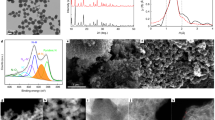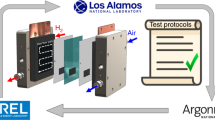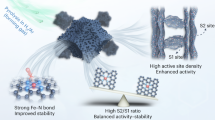Abstract
The oxygen reduction reaction (ORR) is the key bottleneck in the performance of fuel cells. So far, the most active and stable electrocatalysts for the reaction are based on Pt group metals. Transition metal oxides (TMOs) constitute an alternative class of materials for achieving operational stability under oxidizing conditions. Unfortunately, TMOs are generally found to be less active than Pt. Here, we identify two reasons why it is difficult to find TMOs with a high ORR activity. The first is that TMO surfaces consistently bind oxygen atoms more weakly than transition metals do. This makes the breaking of the O–O bond rate-determining for the broad range of TMO surfaces investigated here. The second is that electric field effects are stronger at TMO surfaces, which further makes O–O bond breaking difficult. To validate the predictions and ascertain their generalizability for TMOs, we report experimental ORR catalyst screening for 7,798 unique TMO compositions that generally exhibit activity well below that of Pt.

This is a preview of subscription content, access via your institution
Access options
Access Nature and 54 other Nature Portfolio journals
Get Nature+, our best-value online-access subscription
$29.99 / 30 days
cancel any time
Subscribe to this journal
Receive 12 digital issues and online access to articles
$119.00 per year
only $9.92 per issue
Buy this article
- Purchase on Springer Link
- Instant access to full article PDF
Prices may be subject to local taxes which are calculated during checkout





Similar content being viewed by others
Data availability
The experimental data are available at https://data.caltech.edu/records/1632 (https://doi.org/10.22002/D1.1632). The computational data, which include the O, HO and HOO binding energies, the free energies of 4e– ORR, the optimized atomic coordinates and the scripts for structure modelling, are available at https://github.com/cattheory-oxides/data. All the data are available from the authors upon reasonable request.
References
Kulkarni, A., Siahrostami, S., Patel, A. & Nørskov, J. K. Understanding catalytic activity trends in the oxygen reduction reaction. Chem. Rev. 118, 2302–2312 (2018).
Gasteiger, H. A. & Markovic, N. M. Just a dream or future reality? Science 324, 48–49 (2009).
Debe, M. K. Electrocatalyst approaches and challenges for automotive fuel cells. Nature 486, 43–51 (2012).
Marković, N. M., Schmidt, T. J., Stamenković, V. & Ross, P. N. Oxygen reduction reaction on Pt and Pt bimetallic surfaces: a selective review. Fuel Cells 1, 105–116 (2001).
Escudero-Escribano, M. et al. Tuning the activity of Pt alloy electrocatalysts by means of the lanthanide contraction. Science 352, 73–76 (2016).
Greeley, J. et al. Alloys of platinum and early transition metals as oxygen reduction electrocatalysts. Nat. Chem. 1, 552–556 (2009).
Sakong, S. & Groß, A. Water structures on a Pt(111) electrode from ab initio molecular dynamic simulations for a variety of electrochemical conditions. Phys. Chem. Chem. Phys. 22, 10431–10437 (2020).
Ota, K. I. et al. Development of group 4 and 5 metal oxide-based cathodes for polymer electrolyte fuel cell. J. Power Sources 196, 5256–5263 (2011).
Stein, H. S. et al. Functional mapping reveals mechanistic clusters for OER catalysis across (Cu–Mn–Ta–Co–Sn–Fe)Ox composition and pH space. Mater. Horiz. 6, 1251–1258 (2019).
Haber, J. A. et al. Discovering Ce-rich oxygen evolution catalysts, from high throughput screening to water electrolysis. Energy Environ. Sci. 7, 682–688 (2014).
Wang, Y., Li, J. & Wei, Z. Transition-metal-oxide-based catalysts for the oxygen reduction reaction. J. Mater. Chem. A 6, 8194–8209 (2018).
Wang, Y. et al. Synergistic Mn–Co catalyst outperforms Pt on high-rate oxygen reduction for alkaline polymer electrolyte fuel cells. Nat. Commun. 10, 1506 (2019).
Dickens, C. F., Kirk, C. & Nørskov, J. K. Insights into the electrochemical oxygen evolution reaction with ab initio calculations and microkinetic modeling: beyond the limiting potential volcano. J. Phys. Chem. C. 123, 18960–18977 (2019).
Hansen, H. A., Viswanathan, V. & Nørskov, J. K. Unifying kinetic and thermodynamic analysis of 2e– and 4e– reduction of oxygen on metal surfaces. J. Phys. Chem. C 118, 6706–6718 (2014).
Kelly, S. R., Kirk, C., Chan, K. & Nørskov, J. K. Electric field effects in oxygen reduction kinetics: rationalizing pH dependence at the Pt(111), Au(111), and Au(100) electrodes. J. Phys. Chem. C 124, 14581–14591 (2020).
Nørskov, J. K. et al. Origin of the overpotential for oxygen reduction at a fuel-cell cathode. J. Phys. Chem. B 108, 17886–17892 (2004).
Wang, J. X., Markovic, N. M. & Adzic, R. R. Kinetic analysis of oxygen reduction on Pt(111) in acid solutions: intrinsic kinetic parameters and anion adsorption effects. J. Phys. Chem. B 108, 4127–4133 (2004).
Dickens, C. F., Montoya, J. H., Kulkarni, A. R., Bajdich, M. & Nørskov, J. K. An electronic structure descriptor for oxygen reactivity at metal and metal–oxide surfaces. Surf. Sci. 681, 122–129 (2019).
Duan, Z. & Henkelman, G. Theoretical resolution of the exceptional oxygen reduction activity of Au(100) in alkaline media. ACS Catal. 9, 5567–5573 (2019).
Chen, L. D., Urushihara, M., Chan, K. & Nørskov, J. K. Electric field effects in electrochemical CO2 reduction. ACS Catal. 6, 7133–7139 (2016).
Lamoureux, P. S., Singh, A. R. & Chan, K. pH effects on hydrogen evolution and oxidation over Pt(111): insights from first-principles. ACS Catal. 9, 6194–6201 (2019).
Mittermeier, T., Madkikar, P., Wang, X., Gasteiger, H. A. & Piana, M. ZrO2 based oxygen reduction catalysts for PEMFCs: towards a better understanding. J. Electrochem. Soc. 163, F1543 (2016).
Jung, J. W., Kim, G. Y., Lee, N. W. & Ryu, W. H. Low-temperature synthesis of tetragonal phase of hafnium oxide using polymer-blended nanofiber precursor. Appl. Surf. Sci. 533, 147496 (2020).
Matsui, T. et al. Catalytic activities for oxygen reduction reaction of group 4 and 5 transition metal oxide-based compounds in alkaline solution. 220th ECS Meeting Abstracts 2011-02 293 (Electrochemical Society, 2011).
Hu, S. Corrosion-Resistant Transition Metal Oxides and Oxynitrides Evaluated as Potential Non-Noble Metal Electrocatalysts for the Oxygen Reduction Reaction. PhD thesis, State Univ. of New York at Stony Brook (2015).
Carneiro, J. F., Paulo, M. J., Siaj, M., Tavares, A. C. & Lanza, M. R. V. Zirconia on reduced graphene oxide Sheets: synergistic catalyst with high selectivity for H2O2 electrogeneration. ChemElectroChem 4, 508–513 (2017).
Carneiro, J. F., Paulo, M. J., Siaj, M., Tavares, A. C. & Lanza, M. R. V. Nb2O5 nanoparticles supported on reduced graphene oxide sheets as electrocatalyst for the H2O2 electrogeneration. J. Catal. 332, 51–61 (2015).
Barros, W. R. P. et al. Oxygen reduction to hydrogen peroxide on Fe3O4 nanoparticles supported on Printex carbon and graphene. Electrochim. Acta 162, 263–270 (2015).
Wan, H., Jensen, A. W., Escudero-Escribano, M. & Rossmeisl, J. Insights in the oxygen reduction reaction: from metallic electrocatalysts to diporphyrins. ACS Catal. 10, 5979–5989 (2020).
Gregoire, J. M., Xiang, C., Liu, X., Marcin, M. & Jin, J. Scanning droplet cell for high throughput electrochemical and photoelectrochemical measurements. Rev. Sci. Instrum. 84, 024102 (2013).
Jones, R. J. R. et al. Parallel electrochemical treatment system and application for identifying acid-stable oxygen evolution electrocatalysts. ACS Comb. Sci. 17, 71–75 (2015).
Perdew, J. P., Burke, K. & Ernzerhof, M. Generalized gradient approximation made simple. Phys. Rev. Lett. 77, 3865–3868 (1996).
Hammer, B., Hansen, L. B. & Nørskov, J. K. Improved adsorption energetics within density-functional theory using revised Perdew–Burke–Ernzerhof functionals. Phys. Rev. B 59, 7413 (1999).
Blöchl, P. E. Projector augmented-wave method. Phys. Rev. B 50, 17953–17979 (1994).
Kohn, W. & Sham, L. J. Self-consistent equations including exchange and correlation effects. Phys. Rev. 140, A1133 (1965).
Ishihara, A., Shibata, Y., Mitsushima, S. & Ota, K. Partially oxidized tantalum carbonitrides as a new nonplatinum cathode for PEFC–1–. J. Electrochem. Soc. 155, B400–B406 (2008).
Nam, K. D., Ishihara, A., Matsuzawa, K., Mitsushima, S. & Ota, K. I. Partially oxidized niobium carbonitride as non-platinum cathode for PEFC. Electrochem. Solid-State Lett. 12, B158 (2009).
Takasu, Y., Oohori, K., Yoshinaga, N. & Sugimoto, W. An examination of the oxygen reduction reaction on RuO2-based oxide coatings formed on titanium substrates. Catal. Today 146, 248–252 (2009).
Liu, Y., Ishihara, A., Mitsushima, S. & Ota, K. Influence of sputtering power on oxygen reduction reaction activity of zirconium oxides prepared by radio frequency reactive sputtering. Electrochim. Acta 55, 1239–1244 (2010).
Takasu, Y., Suzuki, M., Yang, H., Ohashi, T. & Sugimoto, W. Oxygen reduction characteristics of several valve metal oxide electrodes in HClO4 solution. Electrochim. Acta 55, 8220–8229 (2010).
Seo, J., Cha, D., Takanabe, K., Kubota, J. & Domen, K. Particle size dependence on oxygen reduction reaction activity of electrodeposited TaOx catalysts in acidic media. Phys. Chem. Chem. Phys. 16, 895–898 (2014).
Ishihara, A. et al. Synthesis of nano-TaOx oxygen reduction reaction catalysts on multi-walled carbon nanotubes connected via a decomposition of oxy-tantalum phthalocyanine. Phys. Chem. Chem. Phys. 17, 7643–7647 (2015).
Tominaka, S., Ishihara, A., Nagai, T. & Ota, K. I. Noncrystalline titanium oxide catalysts for electrochemical oxygen reduction reactions. ACS Omega 2, 5209–5214 (2017).
Chisaka, M. Creation of oxygen reduction reaction active sites on titanium oxynitride without increasing the nitrogen doping level. Phys. Chem. Chem. Phys. 20, 15613–15617 (2018).
Acknowledgements
We thank I. Chorkendorff, Y. Zheng (Technical University of Denmark), T. F. Jaramillo (Stanford University) and J. H. Montoya (Toyota Research Institute) for all the helpful discussions. This work was supported by the Toyota Research Institute through the Accelerated Materials Design and Discovery program.
Author information
Authors and Affiliations
Contributions
H.L., S.K., J.M.G. and J.K.N. designed the study and wrote the paper. H.L., S.K., Z.W., M.A., G.T.K.K.G., C.S.A. and S.V. conducted the DFT calculations, data analysis, and microkinetic modelling. D.G., Y.W., J.A.H. and J.M.G. performed the high-throughput experiments.
Corresponding author
Ethics declarations
Competing interests
The authors declare no competing interests.
Additional information
Peer review information Nature Catalysis thanks Guofeng Wang and the other, anonymous, reviewer(s) for their contribution to the peer review of this work.
Publisher’s note Springer Nature remains neutral with regard to jurisdictional claims in published maps and institutional affiliations.
Supplementary information
Supplementary Information
Supplementary Discussion, Methods, Figs. 1–8 and References.
Rights and permissions
About this article
Cite this article
Li, H., Kelly, S., Guevarra, D. et al. Analysis of the limitations in the oxygen reduction activity of transition metal oxide surfaces. Nat Catal 4, 463–468 (2021). https://doi.org/10.1038/s41929-021-00618-w
Received:
Accepted:
Published:
Issue Date:
DOI: https://doi.org/10.1038/s41929-021-00618-w
This article is cited by
-
Surface states of dual-atom catalysts should be considered for analysis of electrocatalytic activity
Communications Chemistry (2023)
-
Continuous electroproduction of formate via CO2 reduction on local symmetry-broken single-atom catalysts
Nature Communications (2023)
-
Steering from electrochemical denitrification to ammonia synthesis
Nature Communications (2023)
-
Transition metal-N2P2 embedded graphene (TM-NPC) as single-atom catalyst for oxygen reduction reaction: a computational study
Theoretical Chemistry Accounts (2023)
-
Heterogeneous assembling 3D free-standing Co@carbon membrane enabling efficient fluid and flexible zinc-air batteries
Nano Research (2023)



